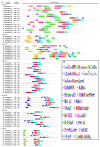Transcriptional Profiles of SmWRKY Family Genes and Their Putative Roles in the Biosynthesis of Tanshinone and Phenolic Acids in Salvia miltiorrhiza
- PMID: 29843472
- PMCID: PMC6032325
- DOI: 10.3390/ijms19061593
Transcriptional Profiles of SmWRKY Family Genes and Their Putative Roles in the Biosynthesis of Tanshinone and Phenolic Acids in Salvia miltiorrhiza
Abstract
Salvia miltiorrhiza Bunge is a Chinese traditional herb for treating cardiovascular and cerebrovascular diseases, and tanshinones and phenolic acids are the dominated medicinal and secondary metabolism constituents of this plant. WRKY transcription factors (TFs) can function as regulators of secondary metabolites biosynthesis in many plants. However, studies on the WRKY that regulate tanshinones and phenolics biosynthesis are limited. In this study, 69 SmWRKYs were identified in the transcriptome database of S. miltiorrhiza, and phylogenetic analysis indicated that some SmWRKYs had closer genetic relationships with other plant WRKYs, which were involved in secondary metabolism. Hairy roots of S. miltiorrhiza were treated by methyl jasmonate (MeJA) to detect the dynamic change trend of SmWRKY, biosynthetic genes, and medicinal ingredients accumulation. Base on those date, a correlation analysis using Pearson's correlation coefficient was performed to construct gene-to-metabolite network and identify 9 SmWRKYs (SmWRKY1, 7, 19, 29, 45, 52, 56, 58, and 68), which were most likely to be involved in tanshinones and phenolic acids biosynthesis. Taken together, this study has provided a significant resource that could be used for further research on SmWRKY in S. miltiorrhiza and especially could be used as a cue for further investigating SmWRKY functions in secondary metabolite accumulation.
Keywords: Salvia miltiorrhiza; SmWRKY; phenolic acid; secondary metabolites; tanshinones.
Conflict of interest statement
The authors declare no conflict of interest.
Figures





Similar articles
-
Comprehensive transcriptome profiling of Salvia miltiorrhiza for discovery of genes associated with the biosynthesis of tanshinones and phenolic acids.Sci Rep. 2017 Sep 5;7(1):10554. doi: 10.1038/s41598-017-10215-2. Sci Rep. 2017. PMID: 28874707 Free PMC article.
-
Molecular cloning and expression analysis of WRKY transcription factor genes in Salvia miltiorrhiza.BMC Genomics. 2015 Mar 17;16(1):200. doi: 10.1186/s12864-015-1411-x. BMC Genomics. 2015. PMID: 25881056 Free PMC article.
-
The AP2/ERF transcription factor SmERF1L1 regulates the biosynthesis of tanshinones and phenolic acids in Salvia miltiorrhiza.Food Chem. 2019 Feb 15;274:368-375. doi: 10.1016/j.foodchem.2018.08.119. Epub 2018 Aug 28. Food Chem. 2019. PMID: 30372953
-
The Biosynthetic Pathways of Tanshinones and Phenolic Acids in Salvia miltiorrhiza.Molecules. 2015 Sep 8;20(9):16235-54. doi: 10.3390/molecules200916235. Molecules. 2015. PMID: 26370949 Free PMC article. Review.
-
Biosynthesis and regulatory mechanism of tanshinones and phenolic acids in Salvia miltiorrhiza.Plant J. 2025 Jul;123(2):e70358. doi: 10.1111/tpj.70358. Plant J. 2025. PMID: 40720694 Review.
Cited by
-
Insights to the superoxide dismutase genes and its roles in Hevea brasiliensis under abiotic stress.3 Biotech. 2022 Oct;12(10):274. doi: 10.1007/s13205-022-03328-7. Epub 2022 Sep 12. 3 Biotech. 2022. PMID: 36110566 Free PMC article.
-
SmMYB4 Is a R2R3-MYB Transcriptional Repressor Regulating the Biosynthesis of Phenolic Acids and Tanshinones in Salvia miltiorrhiza.Metabolites. 2022 Oct 12;12(10):968. doi: 10.3390/metabo12100968. Metabolites. 2022. PMID: 36295870 Free PMC article.
-
CRISPR-Cas gene editing technology and its application prospect in medicinal plants.Chin Med. 2022 Mar 4;17(1):33. doi: 10.1186/s13020-022-00584-w. Chin Med. 2022. PMID: 35246186 Free PMC article. Review.
-
Unveiling the spatial distribution and molecular mechanisms of terpenoid biosynthesis in Salvia miltiorrhiza and S. grandifolia using multi-omics and DESI-MSI.Hortic Res. 2023 May 31;10(7):uhad109. doi: 10.1093/hr/uhad109. eCollection 2023 Jul. Hortic Res. 2023. PMID: 37577405 Free PMC article.
-
Genomic characterization of WRKY transcription factors related to secoiridoid biosynthesis in Gentiana macrophylla.BMC Plant Biol. 2024 Jan 23;24(1):66. doi: 10.1186/s12870-024-04727-z. BMC Plant Biol. 2024. PMID: 38262919 Free PMC article.
References
-
- Han J.-Y., Fan J.-Y., Horie Y., Miura S., Cui D.-H., Ishii H., Hibi T., Tsuneki H., Kimura I. Ameliorating effects of compounds derived from Salvia miltiorrhiza root extract on microcirculatory disturbance and target organ injury by ischemia and reperfusion. Pharmacol. Ther. 2008;117:280–295. doi: 10.1016/j.pharmthera.2007.09.008. - DOI - PubMed
-
- Xu Z., Peters R.J., Weirather J., Luo H., Liao B., Zhang X., Zhu Y., Ji A., Zhang B., Hu S., et al. Full-length transcriptome sequences and splice variants obtained by a combination of sequencing platforms applied to different root tissues of Salvia miltiorrhiza and tanshinone biosynthesis. Plant J. 2015;82:951–961. doi: 10.1111/tpj.12865. - DOI - PubMed
MeSH terms
Substances
LinkOut - more resources
Full Text Sources
Other Literature Sources

